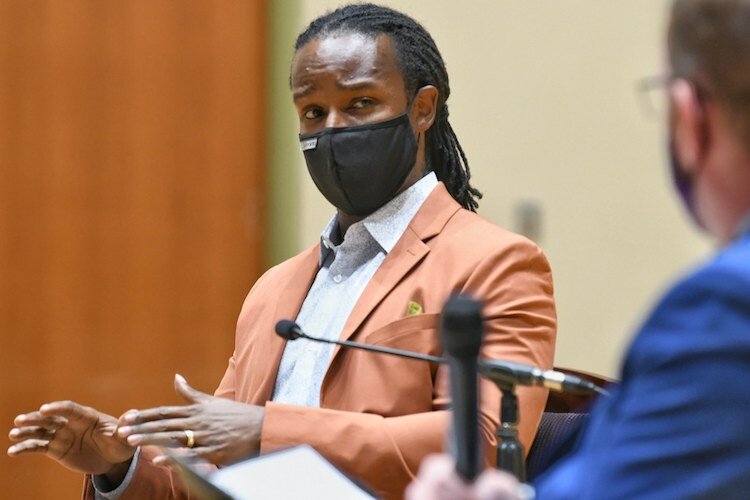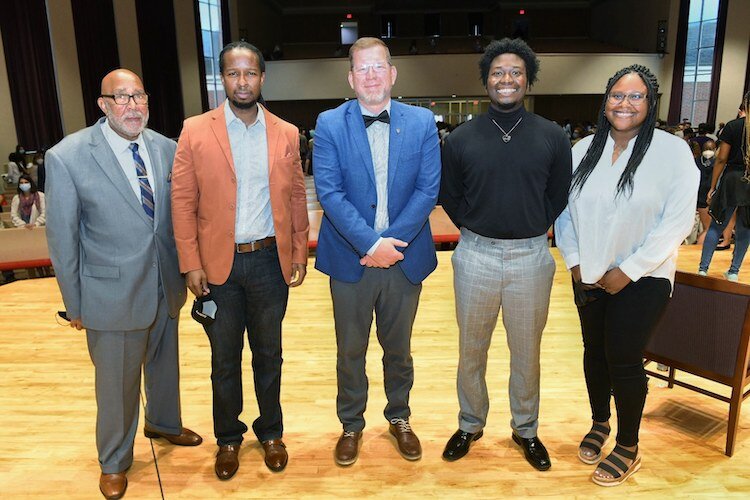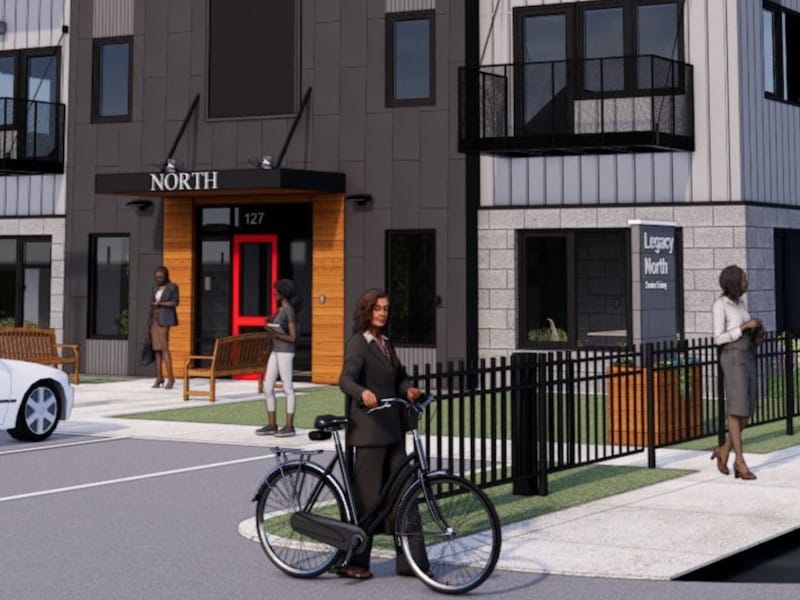In Albion, author of ‘How to Be an Antiracist’ says hold people accountable when they act racist
Dr. Ibram X. Kendi likens racism to a cancer that needs to be cut out. He says people are deeply defensive about the ways they are being racist and need to be held accountable when they are being racist.
Editor’s note: This story is part of Southwest Michigan Second Wave’s On the Ground Calhoun County series.
The words written by Dr. Ibram X. Kendi in his book “How to Be an Antiracist” sprang off the pages and into the minds of audience members who gathered Monday in Albion to listen to a conversation with the noted author, speaker, and teacher.
Kendi appeared onstage at the Goodrich Chapel on Albion College’s campus alongside Akaiia Ridley, a senior at the college majoring in History, and Matthew Johnson, who was formally inaugurated on Saturday as Albion College’s 17th president. In addition to Goodrich Chapel, individuals also gathered inside the Bohm Theatre for a live simulcast of the event which touched on the themes in his book, a No. 1 New York Times bestseller, which was selected for the college’s 2021 Common Reading Experience, a required program for all first-year students.
The antiracist activist is a historian of race and discriminatory policy in America and in July 2020, he became director of the Center for Antiracist Research at Boston University. Kendi was included in Time Magazine’s 100 Most Influential People of 2020.
Ridley began the conversation with the National Book Award winner before a gathering of more than 200 by asking Kendi why he thinks racism needs to be called out when there is an argument being made by some that racism will go away if “we stop focusing on it and talking about it.”
Kendi says if identifying by race were to go away there would be no way to track and collect the data that provides critical information and evidence of racial inequities and racial disparities.
“We’ve learned in the last 20 years that race does not exist genetically and that’s caused some people to say ‘since we know race doesn’t exist genetically why should we talk about it?’” Kendi says. “It’s absolute that race doesn’t exist genetically, but it does exist socially and if we were ever to stop identifying by race we would not be able to collect racial data and see where the race disparities are,” including disproportionately higher death rates of black, brown, and indigenous people. “We could have a society where black, brown, and indigenous people are dying at higher rates.”
When COVID first began its unrelenting assault and took the first of almost 700,000 American lives, Kendi says racial demographics on COVID patients weren’t available. He says data that would show that black people were dying from COVID at disproportionately higher rates was slow in coming.
“All of these experts were saying that black people aren’t taking the virus seriously, but in March of last year the Pew Research Center was saying that black people were taking the virus more seriously than others,” Kendi says.
Research into the causes for the higher COVID death rates highlighted a number of factors including the likelihood that black people are more than other racial groups live in communities with higher levels of pollution and have higher levels of pre-existing conditions due to those environmental conditions. Kendi says black people are less likely to seek treatment at a hospital when they’re in the early stages of COVID because they are less likely to have health insurance, but they are also less likely to live near a hospital with a Level 1 Trauma Center that would give them the best chances to survive.
Rather than blaming black people, Kendi says people need to be identifying the policies that lead to these factors that are part of structural racism. “I would like to get to a point where we don’t have racial disparities and we have anti-racist policies in place that identify those disparities,” he says.
Johnson says as policies are moved forward, some people continue to struggle to understand the difference between racist, antiracist, and no racist.
Kendi says in his book that there is no middle ground when it comes to racism. He says there are many different reasons why people say or want to claim or identify as not being a racist, much of this goes back to how they’ve been taught that being a racist is an identity and that a racist is an “evil, bad person.” No one wants to be labeled as an evil, horrible person, he says.
“Racist and anti-racist are descriptive terms that describe what a person is being at any given moment,” Kendi says. He also pointed out that people are not always consistent in their racism. For example, someone who offers the racist opinion that a black person is lazy may be the same one who fights against the policies that lead to blacks being incarcerated at higher numbers than any other race. “People support policies that lead to equity and inequity.”
Kendi says there are times when a person who says they are antiracist has to admit that they are racist. He says the problem is not so much the people and the differences between races, but the policies and practices responsible for those disparities.
“Racial disparity reflects racial hierarchy,” Kendi says. “Those two groups are equal and neither group is superior or inferior and the group at the lower end is there because of racist policies,” Kendi says. “The cause of racial disparity is racial hierarchy.”
In a lighter moment, Kendi drew laughter from the audience when he said, “When do people say they’re not a racist? Right after they say something that is racist.”
Kendi says he will never shy away from an opportunity to have an open dialog that goes both ways. He says “if somebody comes to me and wants me to be different and change, I will be much more receptive to the person who comes to me from a vulnerable standpoint and says ‘this is something I’m seeking to overcome’ versus ‘these are all the problems you have and we need to change them.’ People are deeply defensive about the ways they are being racist. People need to be held accountable when people are being racist, especially people in power who have the ability to shape policy and lives. Every time you do or say something racist, people should call that out and you should have the courage and the ability to take it.”
When he was writing about how to be an anti-racist, Kendi says he knew that the conversation about race and racism is deeply personal. He knew his book had to have a main character to carry the narrative and complexities of the subject and he had to be able to get into that person’s head. He finally recognized that that person had to be him.
“Unfortunately, I couldn’t find anyone else’s head that I could get into but my own, and I decided to tell my own personal story,” he says.
That story begins with a speech he gave when he was a senior in high school based on a message he imagined Martin Luther King, Jr., would give to millennials.
“And in this speech, in which I thought I was being so progressive and so radical, in fact, I was expressing a litany of anti-black ideas, particularly about black youth. So, I talked about black youth don’t value education. I talked about how black youth keep climbing the high tree of pregnancy, that black youth are not trained well by their parents. And this majority-black crowd of 3,000 largely clapped. And really, that was the moment in which I recognized just how many racist ideas, anti-black racist ideas I had consumed over the course of the ’90s, a time that many of these ideas were mainstream,” he said in an interview with NPR (National Public Radio).
The story was one of several deeply personal moments he shared with the audiences at Goodrich and Bohm. Another came towards the end of his hourlong conversation with the disclosure of a Stage 4 colon cancer diagnosis when he was in his mid-30s. He likened the diagnosis and subsequent treatment to racism.
While cancer was not the diagnosis he wanted to hear, he says he knows his physician was not relaying it to hurt him. He made the analogy between this and times when a loved one comes to a person, they care about to say that they’re being racist.
“In our society people see it as an attack, but that person is diagnosing you in that way so you can get treatment. They need to embrace that person,” he says.
Like cancer, racism only gets worse when the symptoms are ignored.
“What if we understood that diagnosis from a loved one in the same way we understand a diagnosis from cancer and that that person wants to help me,” Kendi says. “I look at tumors as being equivalent to racial inequities and policies. We need to go in and surgically remove racial policies. We have to institute anti-racial policies which are like chemotherapy.”
He says he thinks everyone has it within themselves to defy the odds. Hope is very central to the anti-racist movement.
“When I was diagnosed with cancer the symptoms were extremely painful and it wasn’t as if I could do nothing and not have pain. The symptoms of racism are painful and the January 6 insurrection was a manifestation of that. We had the option of either permanent pain which was doing nothing or pain with additional treatment with the possibility of healing.
“For me, I said I don’t have any other options but to fight to survive. We have to believe that the impossible is possible. Humans have done the impossible time and again. Just because something seems impossible, it doesn’t mean we should not have hope and if we believe we can’t achieve the impossible we will never achieve it.”























